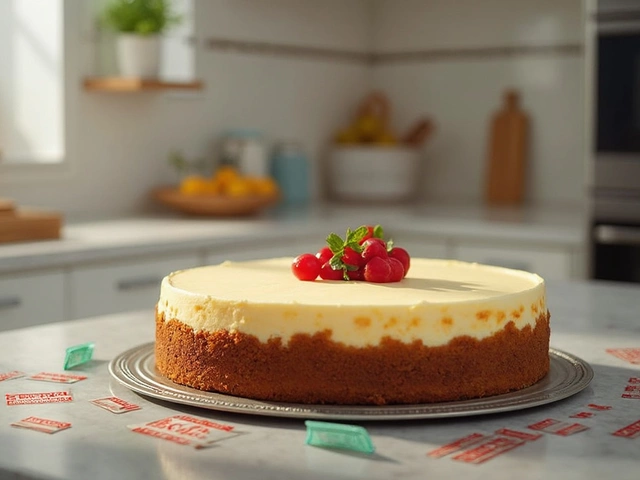
Xanthan gum is one of those ingredients that pops up in almost every gluten-free cake recipe. But is it actually gluten-free or is there something hiding behind that weird name? It’s an honest question, especially if you’re avoiding gluten because of allergies or celiac.
Here’s the straight answer: most xanthan gum you buy is totally gluten-free. Companies make it by fermenting simple sugars, usually from corn. Some brands use wheat, but this is pretty rare now, and they always have to say so on the label. So, always check, especially if your reaction to gluten is strong.
Another thing: xanthan gum doesn’t just replace gluten, it acts as a binder, keeping your cake from falling apart and adding some of that bounce you get in regular wheat cakes. If you’ve ever had a crumbly gluten-free cake that made you sad, xanthan gum fixes that.
Got a super-sensitive gut? Go with brands that guarantee “certified gluten-free” right on the bag. It just gives you that peace of mind.
- What is Xanthan Gum, Really?
- Is Xanthan Gum Actually Gluten-Free?
- How Xanthan Gum Works in Gluten-Free Baking
- How Much Xanthan Gum Should You Use?
- What to Watch Out For (Allergies, Reactions, and Odd Ingredients)
- Baking Hacks: Getting the Best Gluten-Free Cakes
What is Xanthan Gum, Really?
You see xanthan gum all the time in gluten-free baking, but what is it, anyway? In simple terms, xanthan gum is a food additive made from bacteria. Scientists discovered it in the 1960s when they saw how a microbe named Xanthomonas campestris turns sugars into a thick, sticky substance. That sticky stuff is dried out and ground up to give us the powdery xanthan gum we use in kitchens everywhere.
Big factories usually feed the bacteria sugar from corn, but sometimes soy or wheat is used. The good news is, most brands use corn these days because it’s cheap and easy. After fermenting, producers strain the mixture, dry it, and make it into powder. It doesn’t sound pretty, but it works magic in baking.
Xanthan gum’s biggest talent is acting as a binder and stabilizer, which is why it pops up in salad dressings, toothpaste, and even gluten-free frozen pizza. It keeps things from separating, makes liquids thick, and gives batter that stretchy vibe you get from gluten.
- You’ll find it in the ingredient lists for a ton of everyday products, not just baked goods.
- Its weird name comes straight from the bacteria it’s made from—Xanthomonas.
- It’s safe to eat and is FDA-approved as a food additive.
If you like numbers, xanthan gum production tops tens of thousands of tons each year because it’s so useful and cheap to make.
| Source Material | Common Use in Production |
|---|---|
| Corn Sugar | Most common, especially in North America |
| Soy | Sometimes in Asia or special batches |
| Wheat | Rare, always labeled if used |
So, the answer to what xanthan gum is: it’s a stretchy powder from fermented plant sugars, and it’s the secret to holding gluten-free cakes together. If you’re making anything that needs a little ‘stretch’ without gluten, reaching for xanthan gum makes a huge difference.
Is Xanthan Gum Actually Gluten-Free?
Okay, here’s where things get real for anyone baking gluten-free cakes. Xanthan gum comes from fermenting sugar, most commonly from corn, sometimes from soy, or a little less often, from wheat. So there’s this tiny catch: the starting ingredient could be wheat, which is a problem for people super-sensitive to gluten.
The good news? Most xanthan gum on shelves today is made from corn and is gluten-free, especially the brands sold for gluten-free baking. By law in many countries, including the US, if wheat is used, the package has to say so. You’ll see this in the ingredient or allergy warning section right next to the nutrition facts, usually as “contains wheat” or “produced in a facility that processes wheat.”
If certified safety is on your radar (especially if you have celiac), look for these:
- "Certified gluten-free" logos or seals—these are regulated and give you more peace of mind.
- Brands like Bob’s Red Mill and NOW Foods—they very clearly label their xanthan gum as gluten-free.
- Small print: don’t skip it. Sometimes ‘gluten-free’ will be hidden in a little note or on the back panel.
In practice, when you use gluten-free-labeled xanthan gum, you’re safe from gluten. Most cross-contamination risk comes from buying super-cheap brands or bulk bins where labels aren’t clear. So stick with the brands that are upfront about their gluten-free status.
Bottom line: check your labels and you’re good. If you’re extra sensitive, go with brands with third-party gluten-free certification. That way, you can focus on baking and not stress about hidden gluten in your cake.
How Xanthan Gum Works in Gluten-Free Baking
Xanthan gum is like duct tape for gluten-free baking. It sticks things together, which is exactly what you want when you’re baking without wheat. Regular cakes rely on gluten to hold everything in place—without it, your cake turns into a crumbly mess. That’s where xanthan gum steps in.
When you add xanthan gum to your batter, it thickens liquids and traps air bubbles as you mix. This helps your cake hold its shape, rise in the oven, and stay moist instead of drying out or falling apart. Think of it as giving your cake structure and a soft, springy bite, not the sandy texture that sometimes happens in gluten-free baking.
The magic really happens because xanthan gum forms a gel when mixed with water or other liquids. This gel acts a bit like gluten, holding your batter together as it bakes and cools. Here’s how it helps specifically:
- Keeps your cakes from crumbling or falling apart.
- Adds “stretch” and bounce so your cake isn’t dense or gritty.
- Makes the batter easier to mix and spread in your pan.
- Helps your cake stay fresh longer by holding onto moisture.
A lot of gluten-free cake mixes recommend between 1/4 to 1/2 teaspoon of xanthan gum per cup of flour. Too much can make things weirdly gummy though, so don’t go overboard.
If you like numbers, check out how common gluten-free binders perform next to each other:
| Binder | Main Benefit | Recommended per Cup of Flour |
|---|---|---|
| Xanthan gum | Best overall structure and elasticity | 1/4 to 1/2 tsp |
| Guar gum | Similar to xanthan, good for cold recipes | 1/4 to 1/2 tsp |
| Psyllium husk | Adds chewiness, holds moisture | 1 to 2 tbsp |
The bottom line? If you want cakes that taste and feel like the real thing, xanthan gum is a game changer in your gluten-free baking toolbox.

How Much Xanthan Gum Should You Use?
Too much xanthan gum and your cake turns out gummy or even slimy. Too little, and you’ll be sweeping up cake crumbs. The right amount really depends on what you’re baking. For cakes, the general rule is between 1/4 and 1/2 teaspoon of xanthan gum per cup of gluten-free flour blend.
Here’s a super handy breakdown you can count on:
- For gluten-free cakes or quick breads, use 1/4 teaspoon per cup of flour.
- For heavier bakes, like muffins and cookies, 1/4 to 1/2 teaspoon per cup of flour works.
- For denser things like gluten-free bread, go up to 3/4 teaspoon per cup of flour, but not more.
Don’t just toss extra gum in thinking it will help—it won’t! If you overdo it, cakes taste weird and can even have that stretchy, rubber-band feel.
“Using just the right amount of xanthan gum is key. It holds your bake together, but too much will give it a gluey texture, which nobody wants.” – America’s Test Kitchen
If your flour mix already lists xanthan gum, don’t add more. It’s already measured out. Accidentally doubling up can mess with your texture big time.
Tip: Always blend xanthan gum with your dry flour first. Adding it straight to wet ingredients makes it clump. If you’re using a store mix, check the label—the amount might already be perfect and you can skip this step.
What to Watch Out For (Allergies, Reactions, and Odd Ingredients)
Xanthan gum sounds harmless, but there’s more to know before tossing it in your cake mix. While it’s usually made from corn, sometimes it’s made from wheat, soy, or dairy. Always read the label if you have food allergies outside of gluten—some brands spell it out, but sometimes you have to go hunting through fine print or the company website. Look for a “certified gluten-free” label for extra reassurance, especially if you have celiac disease or extreme wheat allergies.
Another thing: xanthan gum can cause stomach troubles for some folks. We’re talking bloating, gas, or diarrhea, especially if you overdo it. It’s a fiber, so your body might push back if you’re sensitive or if you’re new to using it. Start small—most cake recipes only call for ½ to 1 teaspoon anyway.
Once in a blue moon, people have allergic reactions, especially if they’re also allergic to the source (corn, wheat, etc.). Are you super-allergic to corn? Choose a brand that clearly says “corn-free.”
- Check for hidden ingredients or vague phrasing on the label, especially if you have multiple allergies.
- If you’re eating gluten-free for medical reasons, don’t just trust a box that says “gluten-free.” Scan the ingredient list for “wheat-derived” or possible cross-contamination statements.
- When trying a new brand, test with a tiny amount to see how your body reacts first.
- If you’re sensitive to fiber, pick a recipe with less xanthan gum or split your serving size until you’re sure it agrees with you.
And one last tip for anyone new: keep xanthan gum sealed tight and dry. It clumps fast if you leave it out, and those little chunks don’t dissolve well in your cake batter. Keeping it fresh will save you a headache.
So in the world of gluten-free cakes, xanthan gum is a solid helper, but a bit of label reading and smart shopping makes it a whole lot safer and friendlier on your stomach.
Baking Hacks: Getting the Best Gluten-Free Cakes
Making gluten-free cakes taste just as good as regular ones is totally doable, but a few simple hacks make all the difference. Start with a good recipe, but pay extra attention to how you use xanthan gum and the way you mix your batter.
Here’s what’s worked for home bakers and even in commercial kitchens:
- Measure xanthan gum carefully. Too much makes your cake gummy, too little and it crumbles. For most cakes, 1/2 teaspoon per cup of gluten-free flour mix is just right.
- Mix your dry ingredients (including xanthan gum) before adding anything else. This keeps it from clumping and gives an even texture.
- Let your batter sit for 20-30 minutes before baking. Gluten-free flours soak up more liquid, so resting helps prevent grit and dryness.
- Don’t overmix—stir until just combined to keep your cake fluffy, not dense.
- Check for doneness a little early. Gluten-free cakes can dry out fast if overbaked. Start checking 5-10 minutes before the recipe says.
Texture is everything. If you’re not happy with the result, try adding a spoonful of applesauce or yogurt for moisture. Or, swap out part of your flour mix for almond flour—that helps with the bite.
Ever wonder if you’re using the right amount of xanthan gum? Here’s a quick look at common amounts for different gluten-free treats:
| Type of Baked Good | Xanthan Gum (per cup flour) |
|---|---|
| Cakes | 1/2 teaspoon |
| Muffins & Quick Breads | 3/4 teaspoon |
| Cookies | 1/4 teaspoon |
| Bread (yeast-based) | 1 to 1.5 teaspoons |
If you run out of xanthan gum, try psyllium husk or chia seeds. Both work in a pinch, but the results may be a bit different. And when in doubt, grab a gluten-free flour blend that already has xanthan gum mixed in—less to worry about.
One last tip: Don’t judge your gluten-free cake straight from the oven. It often tastes best after cooling for an hour or so. The texture sets, flavors blend, and suddenly, it’s amazing.





